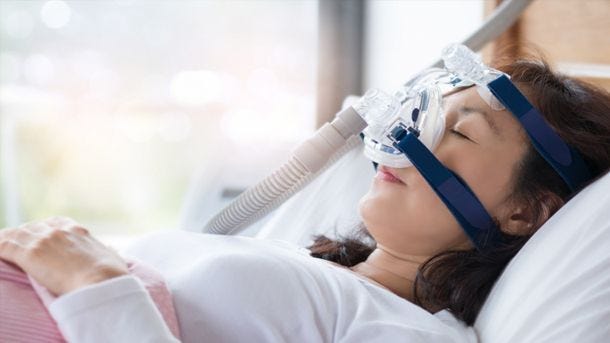How to Find the Perfect CPAP Mask
Are you trying to find the perfect CPAP Mask? Our most recent survey may have some tips that can shorten your search. Hopefully, it will lead you much faster to CPAP compliance or to added comfort or better CPAP therapy.
Mask fit and comfort are the Holy Grail to CPAP therapy. The mask type that best suits your needs depends greatly on personal needs and preferences, comfort and facial structure. Each mask has its own benefits and drawbacks. Unfortunately, there is no silver bullet where one mask is suitable for every need and desire. What might fit one person perfectly might be completely incompatible with someone else. Unfortunately, trying multiple masks is usually the best way forward. Although this is not ideal, it actually is a process everyone should go through to understand the particulars of mask fit, type and style.
The Perfect CPAP Mask Selection Process
The goal with our latest survey was to identify a typical CPAP mask selection process. By understanding this process, it will allow us to better focus on useful and pertinent information and best practices in order for new and seasoned CPAP users to make knowledgeable decisions. We have compiled the answers to create a guide for new CPAP users. These answers will assist and narrow down their mask choices so making a decision is less cumbersome and stressful. We know mask selection can be a challenge given the number of choices available. But sharing the knowledge we gain from veteran CPAP users, it should make the transition to CPAP therapy less onerous and more fulfilling.
A Little about Our CPAP Mask Selection Survey
Roughly 440 people have taken the mask survey to date. With the first question, we separated them into two groups: One group of new CPAP users, and one group of seasoned users who are happy with their current CPAP masks. We further narrowed our response group to only those who use CPAP therapy at least 4 hours nightly (the definition of CPAP compliance) which reduced the subset to 300. This provided a large enough data sampling to set forth some basic mask selection guidelines.
How Did CPAP Users Find Their First Mask, and Is this Process Changing?
First, we wanted to know whether most compliant CPAP users found their first CPAP masks after it was recommended by a sleep professional. As we suspected, most people were referred their first CPAP masks by their sleep doctors. However, we suspect that people new to CPAP therapy may be changing that statistic because the percentage was much lower than expected. This indicates that many more new CPAP users are taking the therapy decisions into their own hands, researching online, and choosing masks on their own.
More than half (56%) of CPAP mask users were recommended their mask by a sleep doctor or technician. More than a quarter (26%) of satisfied CPAP mask users chose their own mask online. And, a little over 9% got their first masks from a medical equipment supply store. Many of our respondents commented that their mask journey involved trial and error. As an example, one respondent said that he tested over a dozen different masks at a sleep clinic. Since then he has used CPAP for 30 years. “My first mask had a very hard rubber nosepiece that I reshaped with a penknife”. He went on to say, “Ever since trying to purchase masks online, I have bought my masks from The CPAP Shop".
A few respondents chose their masks after a recommendation by a family member who had already been on CPAP. Others tried various masks at their sleep studies. The takeaway here is that new users should not be surprised if the first mask they use is not the one they ultimately end up with. Also, mask choices are available, and using multiple masks to get the fit and comfort necessary are part of the process.
Most people seem to go through a trial period with each new mask, weighing its pros and cons. Not surprisingly, nearly every CPAP user seems to always be on a quest for the perfect mask though.
The Quest of the Perfect CPAP Mask Involves Trial and Error
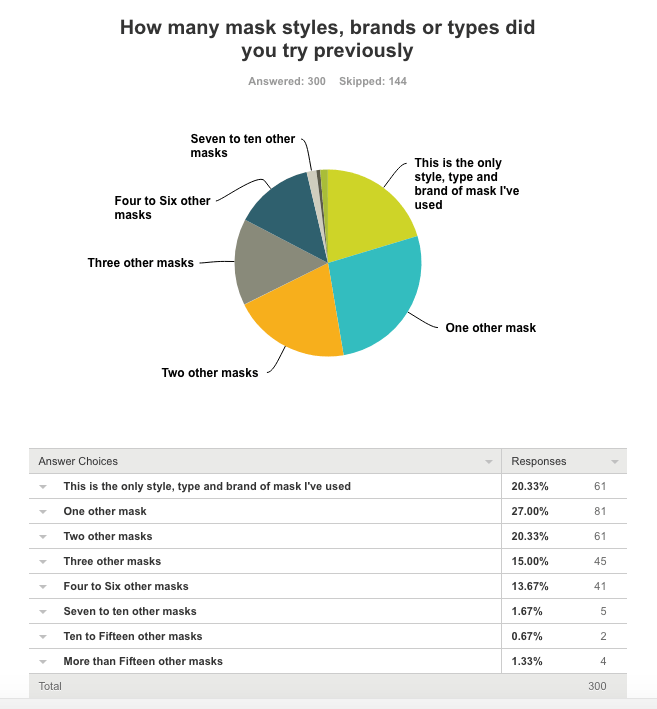
A little over 3 percent of CPAP users try more than 4 masks before they settle. It’s a very personalized process, similar to finding the perfect sneaker or eyeglass style.
Are there Tools to Shorten the Process for the Perfect CPAP Mask?
Most mask manufacturers provide a PDF sizing guide that potential users, intent on purchasing online, can print out, cut out, an fit to their faces. We wondered if this was helpful or even useful. The jury is still out on mask sizing guides. Here is what our survey respondents said. More than half of online mask buyers did not use the PDF mask fit guide. Of those that did, 3 percent said it did not help with mask fit. However, 33% of our CPAP users felt that the PDF did help with mask fit, even though a 2-dimensional piece of paper doesn’t really adjust to a 3 dimensional nose. We will have to do further research to see if the PDF really did shorten the mask fit process, or whether a paper PDF could somehow be improved to better indicate mask fit. We are also curious as to whether PDFs help determine mask fit better for full face masks, nasal masks or nasal cushion masks.
Additionally, many people take advantage of our 30-day mask guarantee and knowledgeable sales staff. Many of our staff members are CPAP users themselves. So, they can easily guide users toward the best type and brand of mask after spending a few minutes on the phone with them, discussing their individual needs. Users can then order a mask, try it, and return it within 30 days paying only the shipping costs. In this way, the trial and error selection process take less time. The risk of a poorly fitted mask is also mitigated.
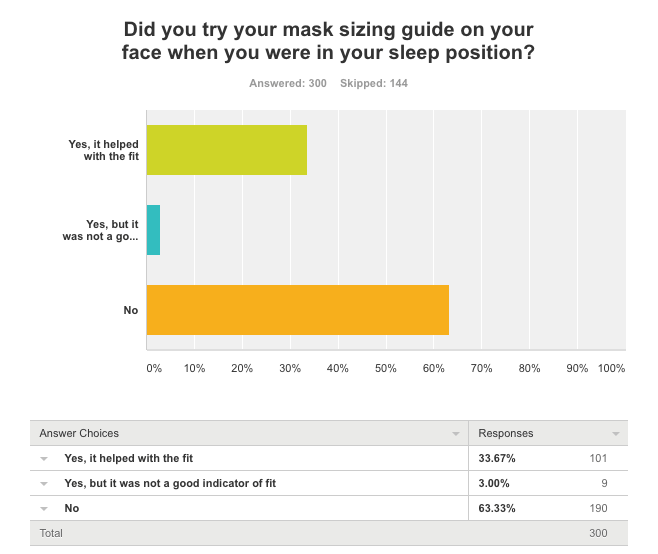
Do Most CPAP users prefer a Nasal Pillow Mask as their Perfect CPAP Mask?
A trend we noticed recently is that more and more people seem to prefer the nasal pillow CPAP masks. Nasal pillow masks offer a clear line of view and have minimal contact with the face. Our survey results confirmed this trend, with 36% using nasal cushion as their main mask, 29% using nasal masks and 29% using full-face masks. A few respondents were confused about the mask categories. nasal masks go around the nose. They are great for CPAP users who breathe through their nose, which can be ensured by adding a chinstrap (to keep the mouth closed). Full-face masks go around both the nose and mouth, and are usually prescribed for mouth breathers. Nasal pillow masks go only around the base of the nostrils using a soft flexible pillow seal. They are great for anyone who feels claustrophobic or for people with facial hair.
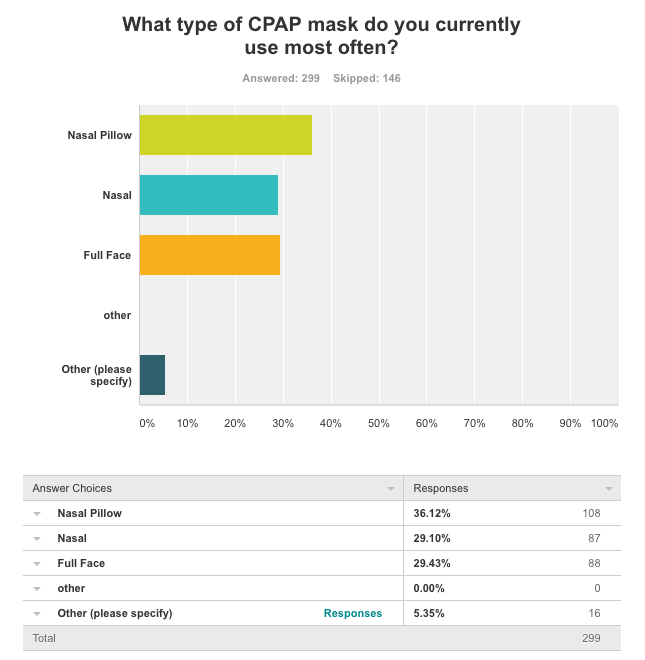
Only 100 of our 300 compliant CPAP users answered the question about why they chose their current mask. Perhaps our answers did not fully explain the process. We hope to delve into this in a future survey, but then from the 103 responses we did receive it seems that many people choose a mask based on their sleep position (side or stomach) and their doctor’s suggestions.
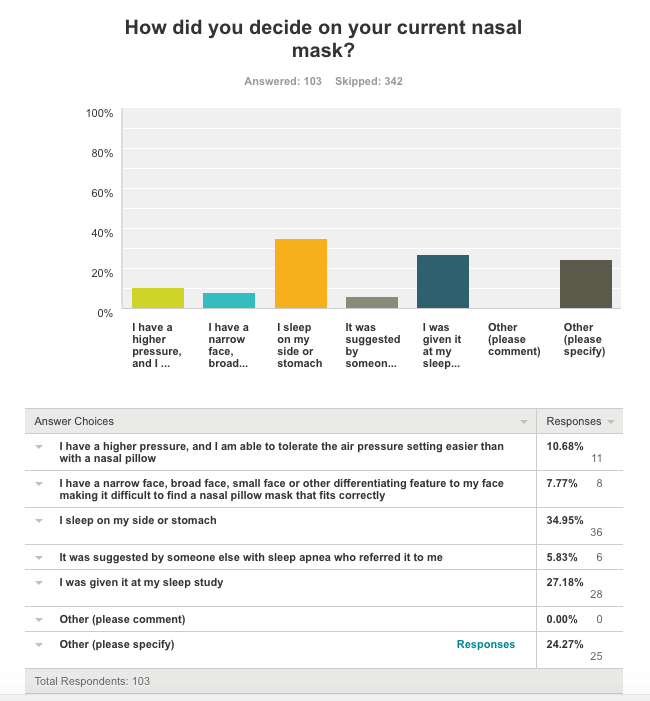
These two decision factors accounted for more than 50 percent of our respondent’s reasons for mask selection. A little more than 10 percent of respondents chose nasal pillows because they could tolerate higher pressures with that mask type, a little over 7 percent chose a mask other than a nasal pillow due to specific physical facial features, and just over 5 percent of respondents chose their mask based on suggestions from friends or family who had tried those masks. A few people responded that they bought masks based on email advertisements, recommendations from local medical supply stores, or after they tried several different types of masks and chose the most comfortable.
Nasal Pillow CPAP Masks Chosen as the Perfect CPAP Mask for Comfort
Since many of our respondents prefer nasal pillow masks, we wanted to know what the most important features were in their decision making process.
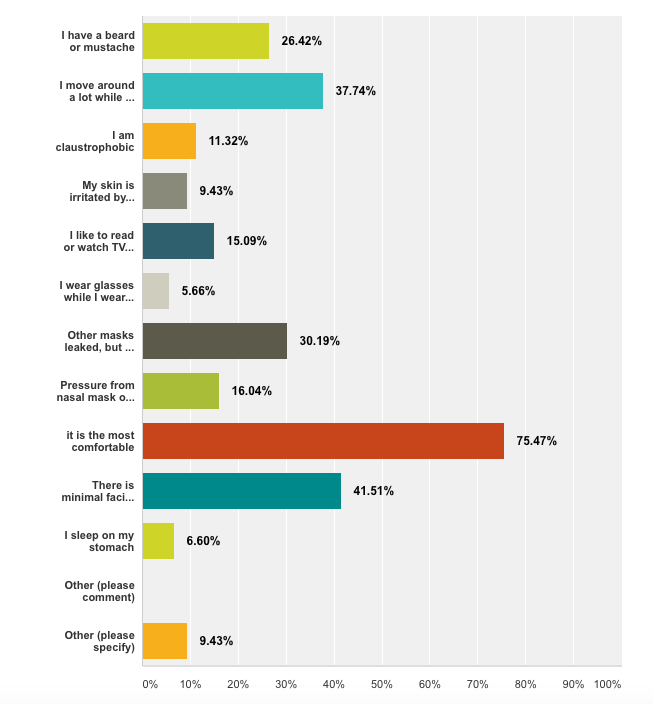
Three quarters of nasal pillow mask users chose it because it was the most comfortable mask for them. Other responses included:
- There is minimal facial contact (41 percent)
- It allows me to move around while I sleep (37 percent)
- Other masks leaked but the nasal canola direct air down my nasal passage and avoid air pressure leaks (30 percent)
- It works the best for facial hair (26 percent)
- The open mask frame allows me to easily watch television or read with the mask on (15 percent)
- There is no pressure on my nose or forehead (15 percent)
- It makes the mask seem less claustrophobic (11 percent)
- There is fewer places where it touches my face and therefore causes less skin irritation (9 percent)
- It allows me to easily wear glasses while I wear the mask (5 percent)
- I chose it because I sleep on my stomach (6 percent)
Some of our nasal pillow mask users provided additional reasons:
“Nasal masks make my nose hot/cold from all the breath in and out--very distracting!”
“I don't have a hose trunk coming out of my face with this mask.”
“I get headaches wearing head gear. Wearing the around the ear gear works good for me.”
“It has a baffle for the exit air - doesn't bother my sleeping spouse”
Most Mouth Breathers Choose Full-face CPAP Masks
We also asked our Full-Face CPAP mask users the reasons why they prefer the mask they chose. 65 percent choose a full-face mask because they breathe through their mouth when they sleep. 30 percent of full-face mask users experienced leaks with nasal or nasal pillow masks. Some of the other most common reasons for using a full-face mask included:
- I have a beard or mustache (22 percent)
- High pressure setting. This mask type distributes the pressure over my whole face making it easier to tolerate (21 percent)
- I did not want to wear a chin strap (14 percent)
- I have allergies, a deviated septum, or some other nasal obstruction and the full face mask helps with that (14 percent)
- Pressure on my forehead, upper lip or nose made me select full face mask
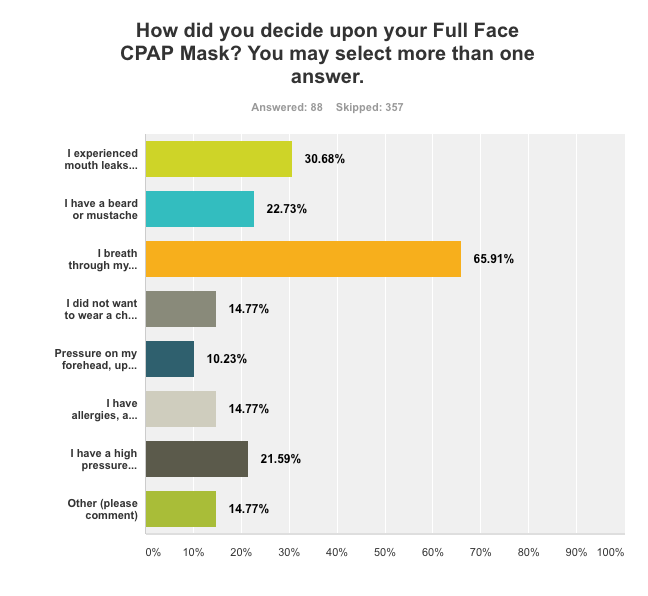
Summary of Guidelines to Find the Perfect CPAP Mask
To summarize, most of our 400 plus survey respondents began their CPAP mask journey based on a recommendation from their sleep lab or sleep physician. But, almost all compliant CPAP therapy users have tried at least 4 CPAP masks before finding and selecting the most appropriate one for themselves. Some have successfully used the PDF sizing guides to find their perfect mask, while others rely on expert sales advice, referrals and trial, and error.
The newest style of CPAP masks, the nasal pillow mask, seems to be gaining in popularity as users discover the comfort offered by its smaller profile and minimal contact with the face. Mouth breathers still prefer the full-face masks to all others. And, stomach sleepers or those with a higher-pressure setting still prefer nasal masks to nasal pillow masks due to fewer potential mask leaks. While this post focused on finding the perfect CPAP mask, in our next post we will discuss users who own multiple masks, mask problems, the motivation to change masks, and some personal mask selection journeys by individual survey respondents who shared their experiences. Read the second installment of the journey to the perfect CPAP mask next!



